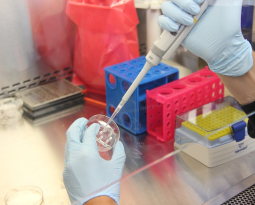West Virginia Patent of the Month – June 2022
Carbon foam is a stiff, porous web of carbon atoms and meets the needs of many engineering projects. The material offers many useful properties including great strength, lightweight, non-flammable, able to perform at high temperatures, sound absorption, and radiation absorption. Following its invention, the material has made its way into the military, industrial, aerospace, and commercial product markets.
CFOAM, LLC has been developing this technology since the early 1990’s as part of an SBIR project for fire walls on US Navy Destroyers. Their innovation and R&D has continued since then as they continued to grow their CFOAM® product technology and other carbon-based foam product technologies.
Recently, the company has developed and patented a method for pore stabilized carbon foam. The traditional process for forming carbon foam is very “organic” in nature, and the resultant product has non-uniform pores. The small pores increase in size while larger pores rise to the top more quickly. The final bubble stability impacts the height of the carbon foam. If the bubbles have a propensity to grow, their tendency to rise increases and reduces the stability of the foam. If the bubble growth is inhibited, the foam is more stable and the product reaches better heights and yields.
For these reasons, CFOAM decided stabilizing pore formation was essential to improving the manufacture of the product. Their method uses a particulate pore stabilizer which promotes the nucleation of bubbles across the volume of foam. This limits any excessive bubble formation from rising up the sides or growing on the bottom of the pan. By introducing this stabilizer in the mesophase, the stabilization is initiated right at the start of the foaming process, creating a uniform distribution of pores from the get go.
This uniform pore size ensures the yielded product is more consistent, and its final properties are more predictable. Given how rapidly carbon foam is being integrated into high engineering designs, consistency and increased yield is essential.
Are you developing new technology for an existing application? Did you know your development work could be eligible for the R&D Tax Credit and you can receive up to 14% back on your expenses? Even if your development isn’t successful your work may still qualify for R&D credits (i.e. you don’t need to have a patent to qualify). To find out more, please contact a Swanson Reed R&D Specialist today or check out our free online eligibility test.
Who We Are:
Swanson Reed is one of the U.S.’ largest Specialist R&D tax advisory firms. We manage all facets of the R&D tax credit program, from claim preparation and audit compliance to claim disputes.
Swanson Reed regularly hosts free webinars and provides free IRS CE and CPE credits for CPAs. For more information please visit us at www.swansonreed.com/webinars or contact your usual Swanson Reed representative.

















